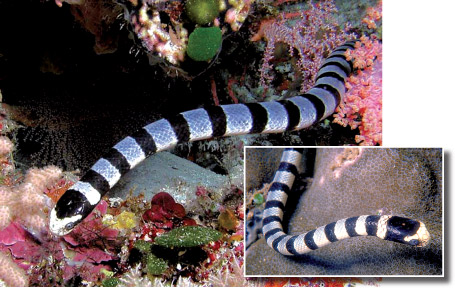
Identifying Sri Lankan krait
Here we produce a snake guide to
identifying and protecting the Sri Lankan krait. The guide was done in
partnership with the Wildlife Conservation Society Galle together with
the American Red Cross Disaster Preparedness Program, Sri Lanka Red
Cross, World Wildlife Fund and the Environmental Foundation Limited.
 The lack of information and awareness on the identification of
venomous snakes, the prevention of snake bites and the provision of
first aid is a major contributing factor to this situation. The clearing
of snake habitats is another cause for increasing bites. The lack of information and awareness on the identification of
venomous snakes, the prevention of snake bites and the provision of
first aid is a major contributing factor to this situation. The clearing
of snake habitats is another cause for increasing bites.
Sri Lankan Krait (Bungarus ceylonicus) 'Karawala' in Sinhala, 'Yennai
Viriyan' in Tamil
Description: A snake with a small head and no clearly defined neck
having a shiny and particularly triangular body. It has an enlarged
hexagonal scales along its skin and has relatively broad white cross
bands.
Behaviour:
* Nocturnal
* Sluggish and does not usually attack during the day time
* When alarmed, it will coil its body, concealing its head within the
coils
* A fully grown adult can reach a length of 80-100cm (2-3 feet)
Venom: Neurotoxic (affects the nervous system)
Symptoms at bite site:
* Mild pain
* Mild or no swelling
* Faint fang-marks may be visible
Symptoms of evenoming (venom entering the body)
* Blurred vision
* Drooping eyelids
* Possible abdominal pain
* Delay in blood clotting will result in loss of blood through vomit,
urine and stools
* Kidney failure
* Difficulty in breathing
What to do in case of a snake bite:
1. Calm the victim and tell him that 70% of snakes who bite do not
inject venom
2. Immobilise the victim and bandage the area of the bite without tying
it too tightly
3. Get the patient to hospital as immediately as possible. The best
place would be the Toxicology Unit at the Peradeniya Hospital
4. Tell the doctor about signs and symptoms of the victim
5. Don't waste your time with healing rituals and snake stones, the best
bet is to treat the patient with proper medication and snake bite
anti-venom. |

